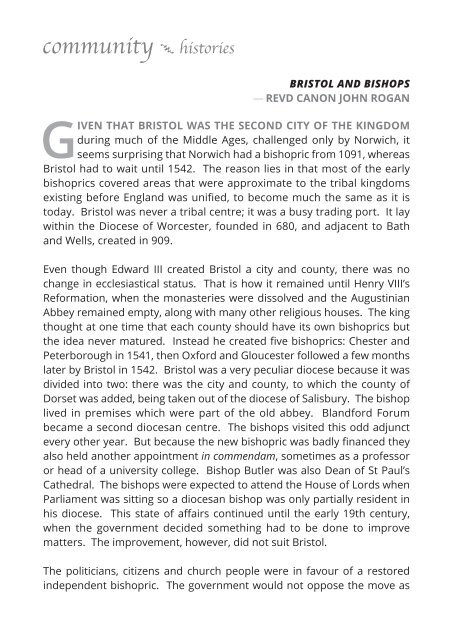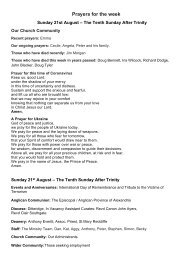Create successful ePaper yourself
Turn your PDF publications into a flip-book with our unique Google optimized e-Paper software.
community histories<br />
BRISTOL AND BISHOPS<br />
— REVD CANON JOHN ROGAN<br />
GIVEN THAT BRISTOL WAS THE SECOND CITY OF THE KINGDOM<br />
during much of the Middle Ages, challenged only by Norwich, it<br />
seems surprising that Norwich had a bishopric from 1091, whereas<br />
Bristol had to wait until 1542. The reason lies in that most of the early<br />
bishoprics covered areas that were approximate to the tribal kingdoms<br />
existing before England was unified, to become much the same as it is<br />
today. Bristol was never a tribal centre; it was a busy trading port. It lay<br />
within the Diocese of Worcester, founded in 680, and adjacent to Bath<br />
and Wells, created in 909.<br />
Even though Edward III created Bristol a city and county, there was no<br />
change in ecclesiastical status. That is how it remained until Henry VIII’s<br />
Reformation, when the monasteries were dissolved and the Augustinian<br />
Abbey remained empty, along with many other religious houses. The king<br />
thought at one time that each county should have its own bishoprics but<br />
the idea never matured. Instead he created five bishoprics: Chester and<br />
Peterborough in 1541, then Oxford and Gloucester followed a few months<br />
later by Bristol in 1542. Bristol was a very peculiar diocese because it was<br />
divided into two: there was the city and county, to which the county of<br />
Dorset was added, being taken out of the diocese of Salisbury. The bishop<br />
lived in premises which were part of the old abbey. Blandford Forum<br />
became a second diocesan centre. The bishops visited this odd adjunct<br />
every other year. But because the new bishopric was badly financed they<br />
also held another appointment in commendam, sometimes as a professor<br />
or head of a university college. Bishop Butler was also Dean of <strong>St</strong> Paul’s<br />
Cathedral. The bishops were expected to attend the House of Lords when<br />
Parliament was sitting so a diocesan bishop was only partially resident in<br />
his diocese. This state of affairs continued until the early 19th century,<br />
when the government decided something had to be done to improve<br />
matters. The improvement, however, did not suit Bristol.<br />
The politicians, citizens and church people were in favour of a restored<br />
independent bishopric. The government would not oppose the move as<br />
long as the necessary funds were found to endow the bishopric. There was<br />
already a programme for building the nave. It had been dismantled in the<br />
later Middle Ages and had never been restored by the time the Abbey was<br />
dissolved. Bristol was known as having the smallest cathedral in England.<br />
That may be true because the cathedral at that time consisted of the<br />
chancel, sanctuary and transepts. The fund-raising for an independent<br />
bishopric went on apace. Even Mr Gladstone made a contribution. By the<br />
later 19th century the necessary money had been raised.<br />
A demarcation dispute followed. There was the hope that the two bishoprics<br />
might be of about the same size but that was not to be. On the other side<br />
of the river was the diocese of Bath and Wells. To this day Long Ashton is<br />
part of this bishopric. The north side between Bristol and Gloucester was<br />
more contentious. One rural deanery was in dispute. Bristol proposed its<br />
inclusion; the Bishop of Gloucester opposed it. Then he changed his mind<br />
and decided it could be included. However, the necessary legislation had<br />
gone through. It was too late for its inclusion.<br />
The Crown moved to appoint the first bishop of the independent see and<br />
chose the Suffragan Bishop of <strong>St</strong>epney, George Forrest Browne, who had<br />
been the first Professor of Archeology in the University of Cambridge. His<br />
bust, modelled by the widow of Captain Scott of Antarctica, can be seen in<br />
the Cathedral’s North Chancel aisle.<br />
So Bristol became an independent see with a series of distinguished<br />
bishops, of whom Oliver Tomkins is the best known. Now it is one of the<br />
first bishoprics to have a female bishop. Bristol relishes its independent<br />
position as a significant member of the Anglican Communion, and is regarded<br />
as one of the pioneers of ecumenism.<br />
Revd Canon John Rogan<br />
Notes for interest —“...in commendam was a form of transferring an ecclesiastical<br />
benefice in trust to the custody of a patron. The phrase was originally applied to the<br />
provisional occupation of an ecclesiastical benefice, which was temporarily without an<br />
actual occupant, in contrast to the conferral of a title, in titulum, which was applied to<br />
the regular and unconditional occupation of a benefice.” // The wife of Captain Scott<br />
was Kathleen Scott, Baroness Kennet FRBS, a British sculptor; also the mother of Sir<br />
Peter Scott, painter and ornithologist. Quote & sources from Wikipedia — Ed


















